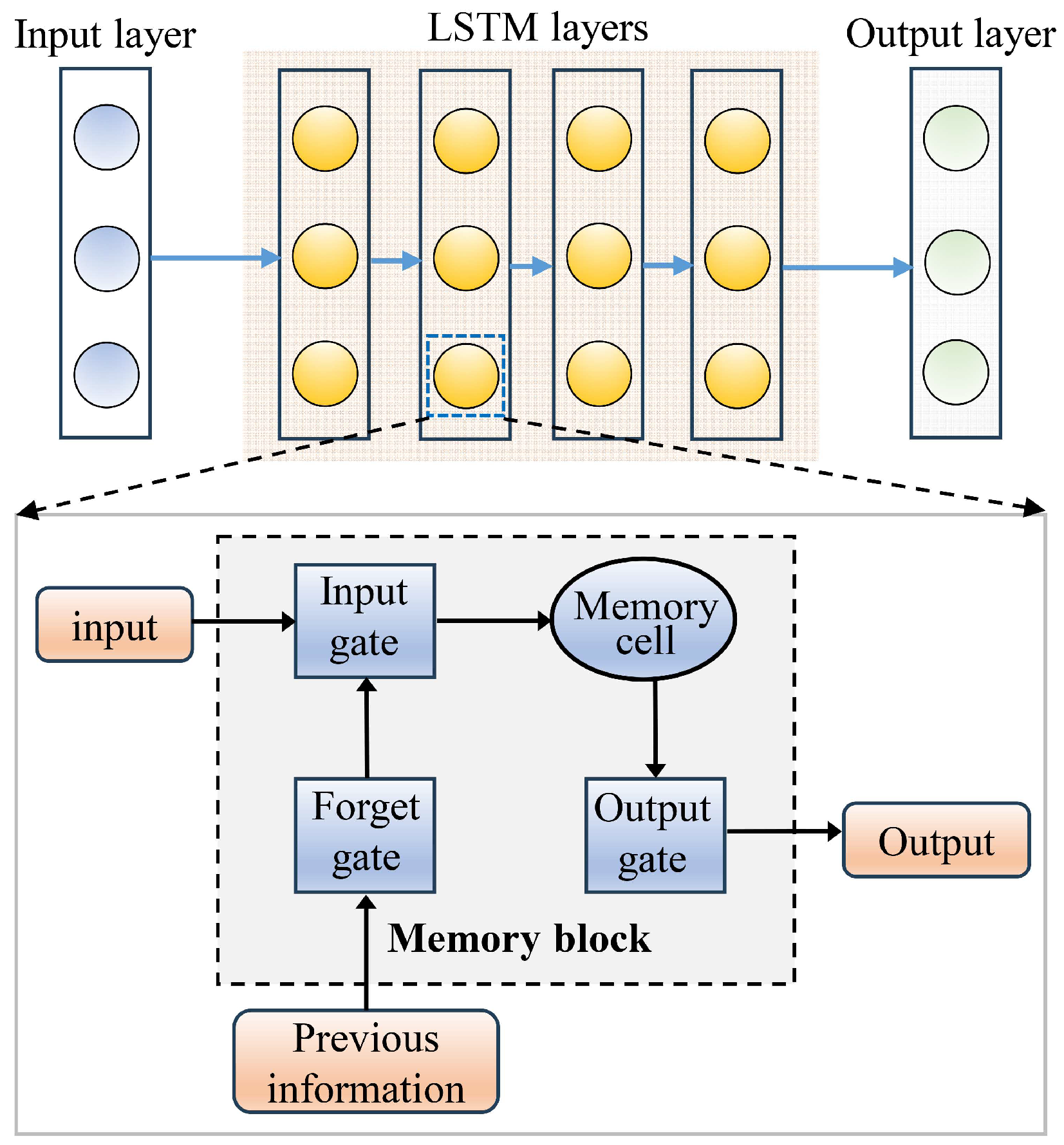Updated Global Navigation Satellite System Observations and Attention-Based Convolutional Neural Network–Long Short-Term Memory Network Deep Learning Algorithms to Predict Landslide Spatiotemporal Displacement
Abstract
:1. Introduction
2. Study Area and Database
2.1. Geological Setting
2.2. Monitoring Scheme
2.3. Monitoring Data
3. Methodology
3.1. Maximal Information Coefficient (MIC)
- (1)
- P1 and P2 are partitioned into x rows or y columns by a division of x-by-y grids signed as G.
- (2)
- D|G is calculated, which is the probability distribution of D on G. The maximum mutual information max I(D|G) is achieved and then used to calculate the corresponding feature matrix as follows.
- (3)
- A different G can lead to a different D|G, and thus the globe optimal G0 can be obtained by exhaustively searching the . The MIC between P1 and P2 is as follows.
3.2. Deep Learning Approaches
3.2.1. Convolutional Neural Network (CNN)
3.2.2. Long Short-Term Memory (LSTM) Neural Network
3.2.3. Attention Mechanism
- (1)
- Spatial attention mechanism
- (2)
- Temporal attention mechanism
3.3. Workflow of Spatiotemporal Displacement Prediction
- (1)
- Date collection
- (2)
- Data preprocessing
- (3)
- Data modeling
3.4. Evaluation of Model Accuracy
- (1)
- Execute forecasting models to predict the displacements of landslides and gather the values of performance measures as datasets. In this study, the predicted outcomes from each chosen monitoring station serve as individual datasets.
- (2)
- The m, n, and k denote the number of forecasting models, datasets, and performance measures, respectively. For the ith indicator, the forecasting models are ranked from 1 to m, represented as .
- (3)
- For the jth forecasting model, the average rank can be determined.
- (4)
- The Friedman statistic, denoted as Ff, can be calculated.
4. Result
4.1. Spatiotemporal Correlation of Landslide Displacement
4.1.1. Temporal Correlation between Landslide Displacement and External Factors
4.1.2. Spatial Correlation between Various Locations of the Outang Landslide
4.2. Spatiotemporal Displacement Prediction of the Outang Landslide Using Attention-Based CNN-LSTM
4.2.1. Procedure of Attention-Based CNN-LSTM Model
4.2.2. Prediction Results of Attention-Based CNN-LSTM Model
4.2.3. Accuracy Comparison of the LSTM Model, CNN-LSTM Model, and Attention-Based CNN-LSTM Model
- (1)
- According to Figure 13a,b, the attention-based CNN-LSTM model exhibited a smaller RMSE and MAE than both the LSTM model and CNN-LSTM model, indicating a superior prediction performance, particularly for GPS08 and GPS10. However, it was important to note that the attention-based CNN-LSTM model did not consistently outperform the other models on GPS04, GPS06, GPS07, and GPS12. The forecasting accuracy of the proposed model was even worse than the CNN-LSTM model for GPS12.
- (2)
- Derived from Figure 13c, the attention-based CNN-LSTM model exhibited varying prediction performances across the six GPS monitoring stations. Notably, for GPS04, which had a relatively smaller displacement rate, the forecasting model demonstrated a better prediction performance compared to stations with larger displacement rates, such as GPS08, GPS10, and GPS12. This pattern was also observed in the LSTM model and CNN-LSTM model.
- (3)
- The R² values of the attention-based CNN-LSTM model consistently surpassed those of the other two models across all six monitoring points, signifying an enhanced capability in predicting the observed behavior (Figure 13d). Within the attention-based CNN-LSTM model, R² values for these stations ranged from 0.9444 (GPS07) to 0.9989 (GPS08). In comparison, the R² ranges were wider for the CNN-LSTM model (0.8715 for GPS07 to 0.9982 for GPS01) and the LSTM model (0.8573 for GPS07 to 0.9973 for GPS08). This suggested that the LSTM model can achieve a commendable prediction performance for specific individual points, yet it lacked consistency across all monitoring points within the landslide due to its inability to account for spatial correlation. While both models take spatial correlation into consideration, the attention-based CNN-LSTM model exhibited a superior prediction performance compared to the CNN-LSTM model. This enhancement can be attributed to the incorporation of a spatial–temporal attention mechanism, which optimizes the performance of the DL model.
- (4)
- The nonparametric Friedman test was employed to discern significant differences among the models used. In this research, we worked with three forecasting models (m), evaluated them across four performance measures (n), and used six distinct datasets (k). The procedure was executed using the SPSS software (IBM SPSS Statistics 27.0.1, Chicago, IL, USA). The p-values of the RMSE, MAPE, MAE, and R2 were all less than 0.05, suggesting a statistically significant variation among the LSTM, CNN-LSTM, and attention-based CNN-LSTM models.
5. Discussion
5.1. Spatiotemporal Deformation Analysis of the Outang Landslide
5.2. Applications, Limitation, and Potential of the Attention-Based CNN-LSTM Model for Spatiotemporal Displacement Prediction
6. Conclusions
Author Contributions
Funding
Data Availability Statement
Acknowledgments
Conflicts of Interest
References
- Guzzetti, F.; Gariano, S.; Peruccacci, S.; Marchesiniet, B.I.; Rossi, M.; Melillo, M. Landslide early warning systems. Earth Sci. Rev. 2020, 200, 102973. [Google Scholar] [CrossRef]
- Wang, Y.; Wen, H.J.; Sun, D.; Li, Y.C. Quantitative assessment of landslide risk based on susceptibility mapping using random forest and GeoDetector. Remote Sens. 2021, 13, 2625. [Google Scholar] [CrossRef]
- Bravo-López, E.; Fernández, D.C.T.; Sellers, C.; Delgado-García, J. Landslide susceptibility mapping of landslides with Artificial Neural Networks: Multi-approach analysis of Backpropagation Algorithm applying the neuralnet package in Cuenca, Ecuador. Remote Sens. 2022, 14, 3495. [Google Scholar] [CrossRef]
- Miao, F.S.; Zhao, F.C.; Wu, Y.P.; Li, L.W.; Török, Á. Landslide susceptibility mapping in Three Gorges Reservoir Area based on GIS and Boosting Decision Tree model. Stoch. Environ. Res. Risk Assess. 2023, 37, 2283–2303. [Google Scholar] [CrossRef]
- Wen, H.J.; Xiao, J.F.; Xiang, X.K.; Wang, X.F.; Zhang, W.G. Singular spectrum analysis-based hybrid PSO-GSA-SVR model for predicting displacement of step-like landslides: A case of Jiuxianping landslide. Acta Geotech. 2023, 1–18. [Google Scholar] [CrossRef]
- Park, J.Y.; Lee, S.R.; Lee, D.H.; Kim, Y.T.; Lee, J.S. A regional-scale landslide early warning methodology applying statistical and physically based approaches in sequence. Eng. Geol. 2019, 260, 105193. [Google Scholar] [CrossRef]
- Pecoraro, G.; Calvello, M.; Piciullo, L. Monitoring strategies for local landslide early warning systems. Landslides 2019, 16, 213–231. [Google Scholar] [CrossRef]
- Yin, Y.P.; Wang, H.D.; Gao, Y.L.; Li, X.C. Real-time monitoring and early warning of landslides at relocated Wushan Town, the Three Gorges Reservoir, China. Landslides 2010, 7, 339–349. [Google Scholar] [CrossRef]
- Macciotta, R.; Hendry, M.; Martin, C.D. Developing an early warning system for a very slow landslide based on displacement monitoring. Nat. Hazards 2020, 81, 887–907. [Google Scholar] [CrossRef]
- Lacroix, P.; Handwerger, A.L.; Bievre, G. Life and death of slow moving landslides. Nat. Rev. Earth Environ. 2020, 1, 404–419. [Google Scholar] [CrossRef]
- Shihabudheen, K.V.; Pillai, G.N.; Peethambaran, B. Prediction of landslide displacement with controlling factors using extreme learning adaptive neuro-fuzzy inference system (ELANFIS). Appl. Soft Comput. 2017, 61, 892–904. [Google Scholar] [CrossRef]
- Yao, W.M.; Li, C.D.; Guo, Y.C.; Criss, E.R.; Zuo, Q.J.; Zhan, H.B. Short-term deformation characteristics, displacement prediction, and kinematic mechanism of Baijiabao landslide based on updated monitoring data. Bull. Eng. Geol. Environ. 2022, 81, 393. [Google Scholar] [CrossRef]
- Tehrani, F.S.; Calvello, M.; Liu, Z.Q.; Zhang, L.M.; Suzanne, L. Machine learning and landslide studies: Recent advances and applications. Nat. Hazards 2022, 114, 1197–1245. [Google Scholar] [CrossRef]
- Liu, Y.; Xu, C.; Huang, B.; Ren, X.W.; Liu, C.Q.; Hu, B.D.; Chen, Z. Landslide displacement prediction based on multi-source data fusion and sensitivity state. Eng. Geol. 2020, 271, 105608. [Google Scholar] [CrossRef]
- Shihabudheen, K.; Peethambaran, B. Landslide displacement prediction technique using improved neuro-fuzzy system. Arab. J. Geosci. 2017, 10, 502. [Google Scholar] [CrossRef]
- Catani, F. Landslide detection by deep learning of non-nadiral and crowdsourced optical images. Landslides 2021, 18, 1025–1044. [Google Scholar] [CrossRef]
- Huang, F.M.; Zhang, J.; Zhou, C.B.; Wang, Y.H.; Huang, J.S.; Zhu, L. A deep learning algorithm using a fully connected sparse autoencoder neural network for landslide susceptibility prediction. Landslides 2020, 17, 217–229. [Google Scholar] [CrossRef]
- Guo, Z.Z.; Tian, B.; Li, G.; Huang, D.; Zeng, T.; He, J.; Song, D. Landslide susceptibility mapping in the Loess Plateau of northwest China using three data-driven techniques-a case study from middle Yellow River catchment. Front. Earth Sci. 2023, 10, 1033085. [Google Scholar] [CrossRef]
- Prakash, E.; Manconi, A.; Loew, S. Mapping landslides on EO data: Performance of deep learning models vs. traditional machine learning models. Remote Sens. 2020, 12, 346. [Google Scholar] [CrossRef]
- Li, L.M.; Wang, C.Y.; Wen, Z.Z.; Gao, J.; Xia, M.F. Landslide displacement prediction based on the ICEEMDAN, ApEn and the CNN-LSTM models. J. Mt. Sci. 2023, 20, 1220–1231. [Google Scholar] [CrossRef]
- Wang, L.Q.; Ting, X.; Liu, S.L.; Zhang, W.G.; Yang, B.B.; Chen, L.C. Quantification of model uncertainty and variability for landslide displacement prediction based on Monte Carlo simulation. Gondwana Res. 2023, 123, 27–40. [Google Scholar] [CrossRef]
- Yang, B.B.; Yin, K.L.; Lacasse, S.; Liu, Z.Q. Time series analysis and long short-term memory neural network to predict landslide displacement. Landslides 2019, 16, 677–694. [Google Scholar] [CrossRef]
- Yang, B.B.; Xiao, T.; Wang, L.Q.; Huang, W. Using complementary ensemble empirical mode decomposition and gated recurrent unit to predict landslide displacements in dam reservoir. Sensors 2022, 22, 1320. [Google Scholar] [CrossRef]
- Nava, L.; Carraro, E.; Reyes, C.C.; Puliero, S.; Bhuyan, K.; Rosi, A.; Monserrat, O.; Floris, M.; Meena, S.R.; Galve, J.P.; et al. Landslide displacement forecasting using deep learning and monitoring data across selected sites. Landslides 2023, 20, 2111–2129. [Google Scholar] [CrossRef]
- Xi, N.; Zang, M.D.; Lin, R.S.; Sun, Y.J.; Mei, G. Spatiotemporal prediction of landslide displacement using deep learning ap-proaches based on monitored time-series displacement data: A case in the Huanglianshu landslide. Georisk 2023, 17, 98–113. [Google Scholar] [CrossRef]
- Jiang, Y.N.; Luo, H.Y.; Xu, Q.; Lu, Z.; Liao, L.; Li, H.J.; Hao, L.N. A graph convolutional incorporating GRU network for landslide displacement forecasting based on spatiotemporal analysis of GNSS observations. Remote Sens. 2022, 14, 1016. [Google Scholar] [CrossRef]
- Khalili, M.A.; Guerriero, L.; Pouralizadeh, M.; Calcaterra, D.; Martire, D.D. Monitoring and prediction of landslide-related deformation based on the GCN-LSTM algorithm and SAR imagery. Nat. Hazards 2023, 119, 39–68. [Google Scholar] [CrossRef]
- Guzzetti, F.; Peruccacci, S.; Rossi, M.; Stark, C.P. Rainfall thresholds for the initiation of landslides in central and southern Europe. Meteorol. Atmos. Phys. 2007, 98, 239–267. [Google Scholar] [CrossRef]
- Medina, V.; Hürlimann, M.; Guo, Z.Z.; Lloret, A.; Vaunat, J. Fast physically-based model for rainfall-induced landslide susceptibility assessment at regional scale. Catena 2021, 201, 105213. [Google Scholar] [CrossRef]
- Guo, Z.Z.; Torra, O.; Hürlimann, M.; Abancó, C.; Medina, V. FSLAM: A QGIS plugin for fast regional susceptibility assessment of rainfall-induced landslides. Environ. Model. Softw. 2022, 150, 105354. [Google Scholar] [CrossRef]
- Hürlimann, M.; Guo, Z.Z.; Puig-Polo, C.; Medina, V. Impacts of future climate and land cover changes on landslide suscepti-bility: Regional scale modeling in the Val d’Aran region (Pyrenees, Spain). Landslides 2022, 19, 99–118. [Google Scholar] [CrossRef]
- Agterberg, F. How Can Earth Science Help Reduce the Adverse Effects of Climate Change? J. Earth Sci. 2022, 33, 1338. [Google Scholar] [CrossRef]
- Yang, H.Q.; Song, K.L.; Chen, L.C.; Qu, L.L. Hysteresis effect and seasonal step-like creep deformation of the Jiuxianping landslide in the Three Gorges Reservoir region. Eng. Geol. 2023, 317, 107089. [Google Scholar] [CrossRef]
- Yao, W.M.; Li, C.D.; Zuo, Q.J.; Zhan, H.B.; Criss, R.E. Spatiotemporal deformation characteristics and triggering factors of Baijiabao landslide in Three Gorges Reservoir region, China. Geomorphology 2019, 343, 34–47. [Google Scholar] [CrossRef]
- Wu, Q.; Tang, H.M.; Ma, X.H.; Wu, Y.P.; Hu, X.L.; Wang, L.Q.; Criss, R.; Yuan, Y.; Xu, Y.J. Identification of movement charac-teristics and causal factors of the Shuping landslide based on monitored displacements. Bull. Eng. Geol. Environ. 2019, 78, 2093–2106. [Google Scholar] [CrossRef]
- Jiang, P.; Chen, J.J. Displacement prediction of landslide based on generalized regression neural networks with K-fold cross-validation. Neurocomputing 2016, 198, 40–47. [Google Scholar] [CrossRef]
- Song, K.; Wang, F.W.; Yi, Q.L.; Lu, S.Q. Landslide deformation behavior influenced by water level fluctuations of the Three Gorges Reservoir (China). Eng. Geol. 2018, 247, 58–68. [Google Scholar] [CrossRef]
- Wang, H.; Long, G.Y.; Shao, P.; Lv, Y.; Gan, F.; Liao, J.X. A DES-BDNN based probabilistic forecasting approach for step-like landslide displacement. J. Clean. Prod. 2023, 394, 136281. [Google Scholar] [CrossRef]
- Guo, Z.Z.; Chen, L.X.; Gui, L.; Du, J.; Yin, K.L.; Do, H.M. Landslide displacement prediction based on variational mode de-composition and WA-GWO-BP model. Landslides 2020, 17, 567–583. [Google Scholar] [CrossRef]
- Reshef, D.N.; Reshef, Y.; Mitzenmacher, M.; Sabeti, P. Equitability analysis of the Maximal Information Coefficient with comparisons. Comput. Sci. 2013, preprint. [Google Scholar] [CrossRef]
- Gu, J.X.; Wang, Z.H.; Kuen, J.; Ma, L.Y.; Shahroudy, A.; Shuai, B.; Liu, T.; Wang, X.X.; Wang, G.; Cai, J.F.; et al. Recent advances in convolutional neural networks. Pattern Recognit. 2018, 77, 354–377. [Google Scholar] [CrossRef]
- Nagi, J.; Ducatelle, F.; Caro, G.A.D.; Cireşan, D.; Meier, U.; Giusti, A.; Nagi, F.; Schmidhuber, J.; Gambardella, L.M. Max-pooling convolutional neural networks for vision-based hand gesture recognition. In Proceedings of the IEEE International Conference on Signal and Image Processing Applications (ICSIPA), Kuala Lumpur, Malaysia, 16–18 November 2011; pp. 342–347. [Google Scholar] [CrossRef]
- Hochreiter, S.; Schmidhuber, J. Long short-term memory. Neural Comput. 1997, 9, 1735–1780. [Google Scholar] [CrossRef]
- Felix, A.F.; Jürgen, S. Recurrent nets that time and count. In Proceedings of the IEEE-INNS-ENNS International Joint Conference on Neural Network, Como, Italy, 27 July 2000; Volume 3, pp. 189–194. [Google Scholar] [CrossRef]
- Liu, Z.Q.; Guo, D.; Suzanne, L.; Li, J.H.; Yang, B.B.; Choi, J.C. Algorithms for intelligent prediction of landslide displacements. Zhejiang Univ. Sci. A 2020, 21, 412–429. [Google Scholar] [CrossRef]
- Rensink, R.A. The dynamic representation of scenes. Vis. Cogn. 2002, 7, 17–42. [Google Scholar] [CrossRef]
- Corbetta, M.; Shulman, G.L. Control of goal-directed and stimulus-driven attention in the brain. Nat. Rev. Neurosci. 2002, 3, 201–215. [Google Scholar] [CrossRef]
- Ren, Q.B.; Li, M.C.; Li, H.; Shen, Y. A novel deep learning prediction model for concrete dam displacements using interpretable mixed attention mechanism. Adv. Eng. Inf. 2021, 50, 101407. [Google Scholar] [CrossRef]
- Guo, M.H.; Xu, T.X.; Liu, J.J.; Liu, Z.N.; Jiang, P.T.; Mu, T.J.; Zhang, S.H.; Martin, R.R.; Cheng, M.M.; Hu, S.M. Attention mechanisms in computer vision: A survey. Vis. Media 2022, 8, 331–368. [Google Scholar] [CrossRef]
- Song, S.; Lan, C.; Xing, J.; Zeng, W.; Liu, J. An endto-end spatio-temporal attention model for human action recognition from skeleton data. In Proceedings of the 31st AAAI Conference on Artificial Intelligence, San Francisco, CA, USA, 4–9 February 2017; pp. 4263–4270. [Google Scholar] [CrossRef]
- Fu, Y.; Wang, X.Y.; Wei, Y.C.; Huang, T. STA: Spatial-temporal attention for large-scale video-based person re-identification. In Proceedings of the AAAI Conference on Artificial Intelligence, Honolulu, HI, USA, 29–31 January 2019; Volume 33, pp. 8287–8294. [Google Scholar] [CrossRef]
- Woo, S.; Park, J.; Lee, J.; Kweon, I.S. CBAM: Convolutional block attention module. In Proceedings of the European Conference on Computer Vision (ECCV), Munich, Germany, 8–14 September 2018; pp. 3–19. [Google Scholar] [CrossRef]
- Liu, Y.Q.; Zhang, Q.; Song, L.H.; Chen, Y.Y. Attention-based recurrent neural networks for accurate short-term and long-term dissolved oxygen prediction. Comput. Electron. Agric. 2019, 165, 104964. [Google Scholar] [CrossRef]
- Saurabh, K.; Sunil, F.R. Context aware recommendation systems: A review of the state of the art techniques. Comput. Sci. Rev. 2020, 37, 100255. [Google Scholar] [CrossRef]
- Ma, J.W.; Xia, D.; Wang, Y.K.; Niu, X.X.; Jiang, S.; Liu, Z.Y.; Guo, H.X. A comprehensive comparison among metaheuristics (MHs) for geohazard modeling using machine learning: Insights from a case study of landslide displacement prediction. Eng. Appl. Artif. Intell. 2022, 114, 105150. [Google Scholar] [CrossRef]
- Ma, J.W.; Xia, D.; Guo, H.X.; Wang, Y.K.; Niu, X.X.; Liu, Z.Y.; Jiang, S. Metaheuristic-based support vector regression for landslide displacement prediction: A comparative study. Landslides 2022, 19, 2489–2511. [Google Scholar] [CrossRef]
- Demšar, J. Statistical comparisons of classifiers over multiple data sets. J. Mach. Learn. Res. 2006, 7, 1–30. [Google Scholar]
- Wang, L.; Wu, C.; Yang, Z.Y.; Wang, L.Q. Deep learning methods for time-dependent reliability analysis of reservoir slopes in spatially variable soils. Comput. Geotech. 2023, 159, 105413. [Google Scholar] [CrossRef]
- Guo, Z.Z.; Chen, L.X.; Yin, K.L.; Shrestha, D.P.; Zhang, L. Quantitative risk assessment of slow-moving landslides from the viewpoint of decision-making: A case study of the Three Gorges Reservoir in China. Eng. Geol. 2020, 273, 105667. [Google Scholar] [CrossRef]
- Ketkar, N.; Moolayil, J. Introduction to PyTorch. In Deep Learning with Python; Apress: Berkeley, CA, USA, 2020; pp. 27–91. [Google Scholar] [CrossRef]
- Kingma, D.P.; Ba, J. Adam: A method for stochastic optimization. In Proceedings of the 3rd International Conference on Learning Representations, San Diego, CA, USA, 7–9 May 2015. [Google Scholar] [CrossRef]
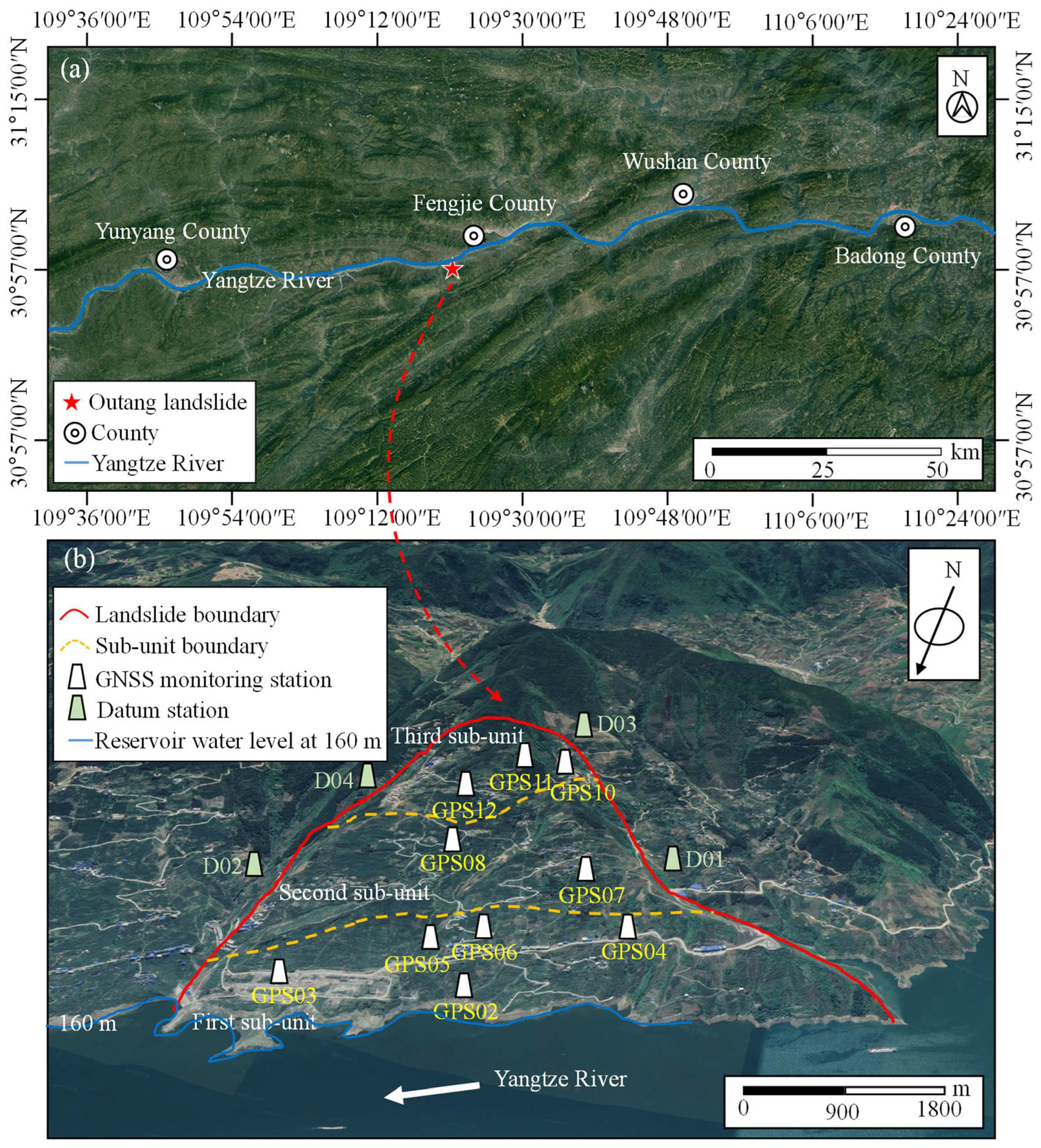
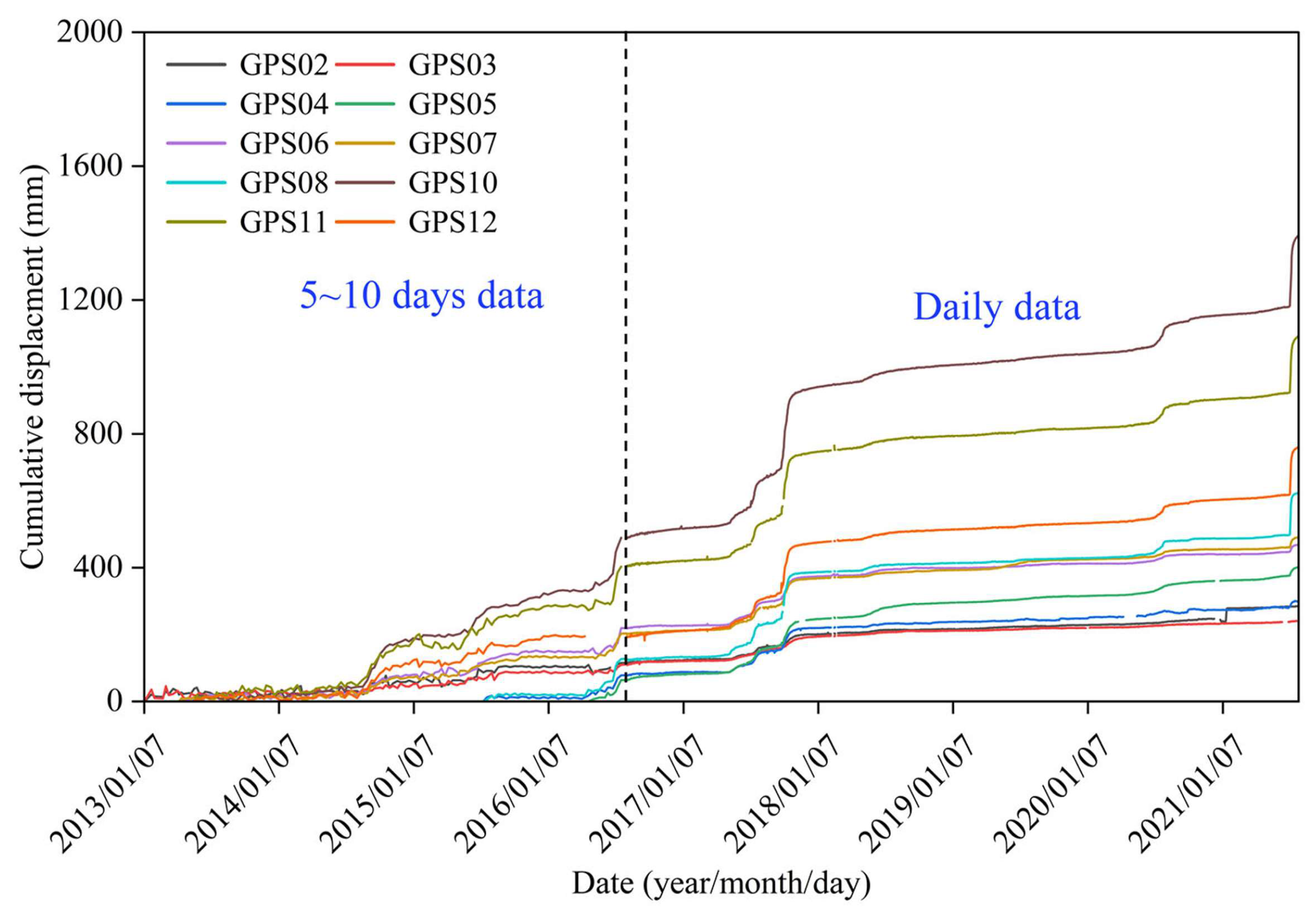
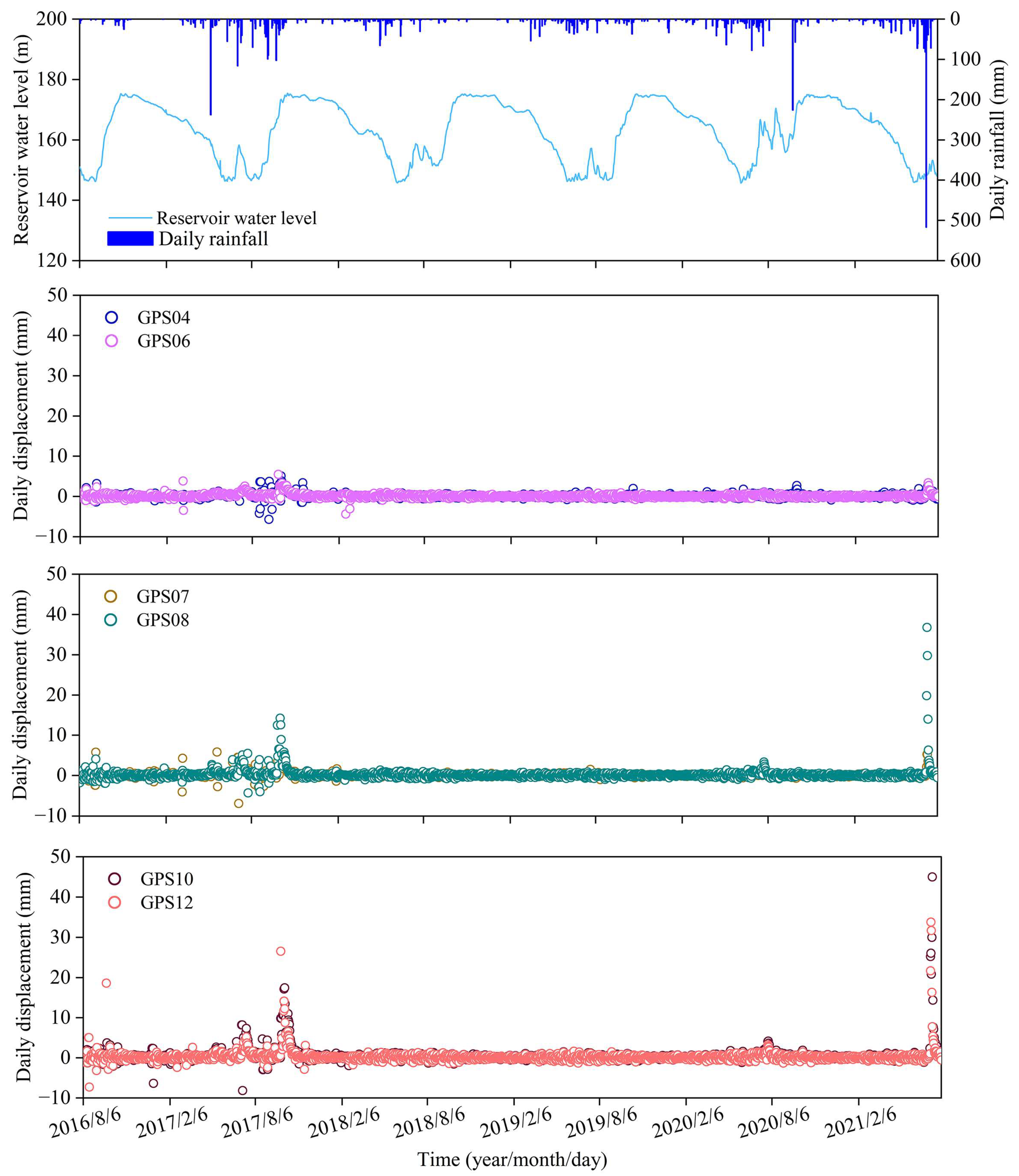
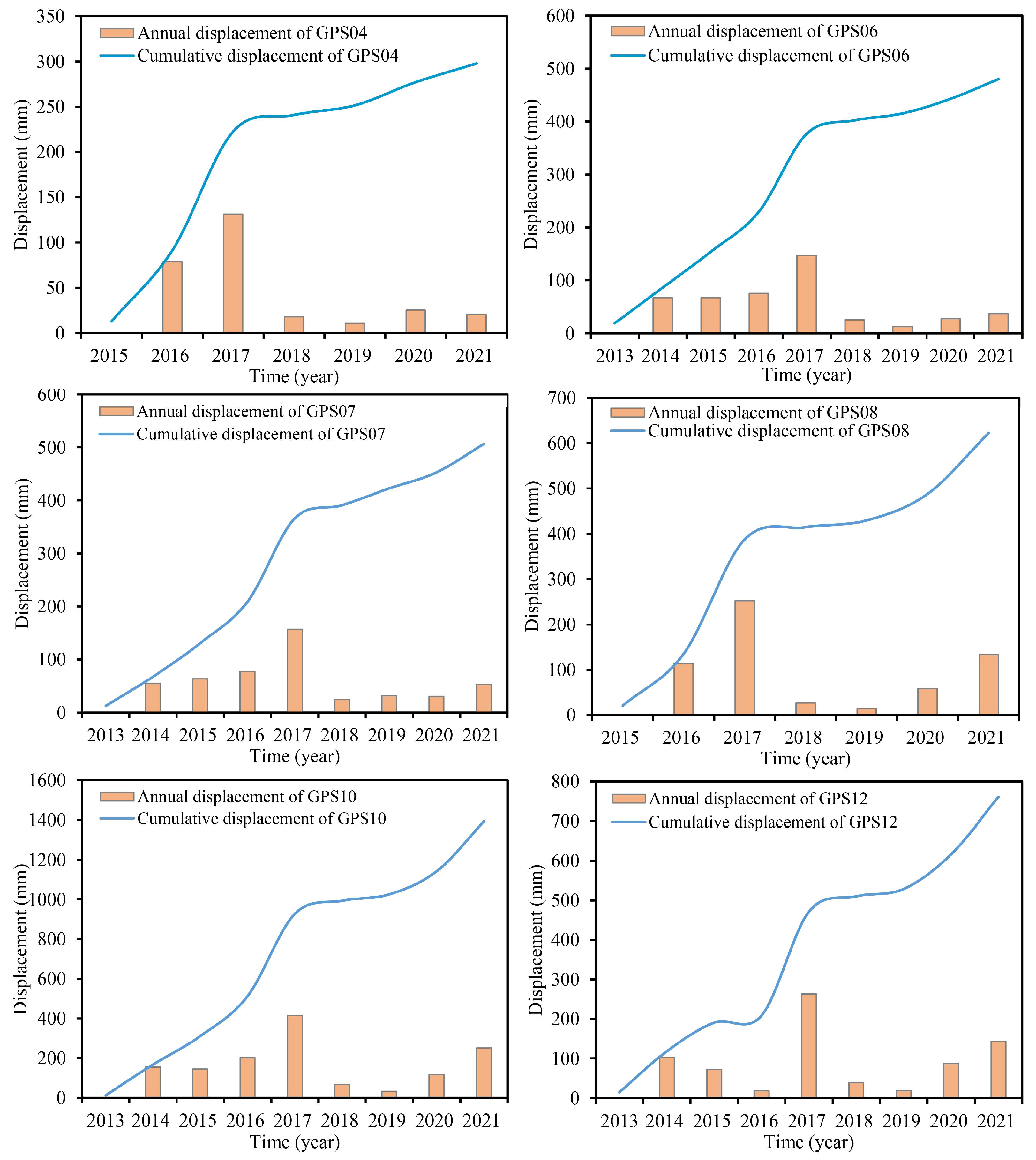

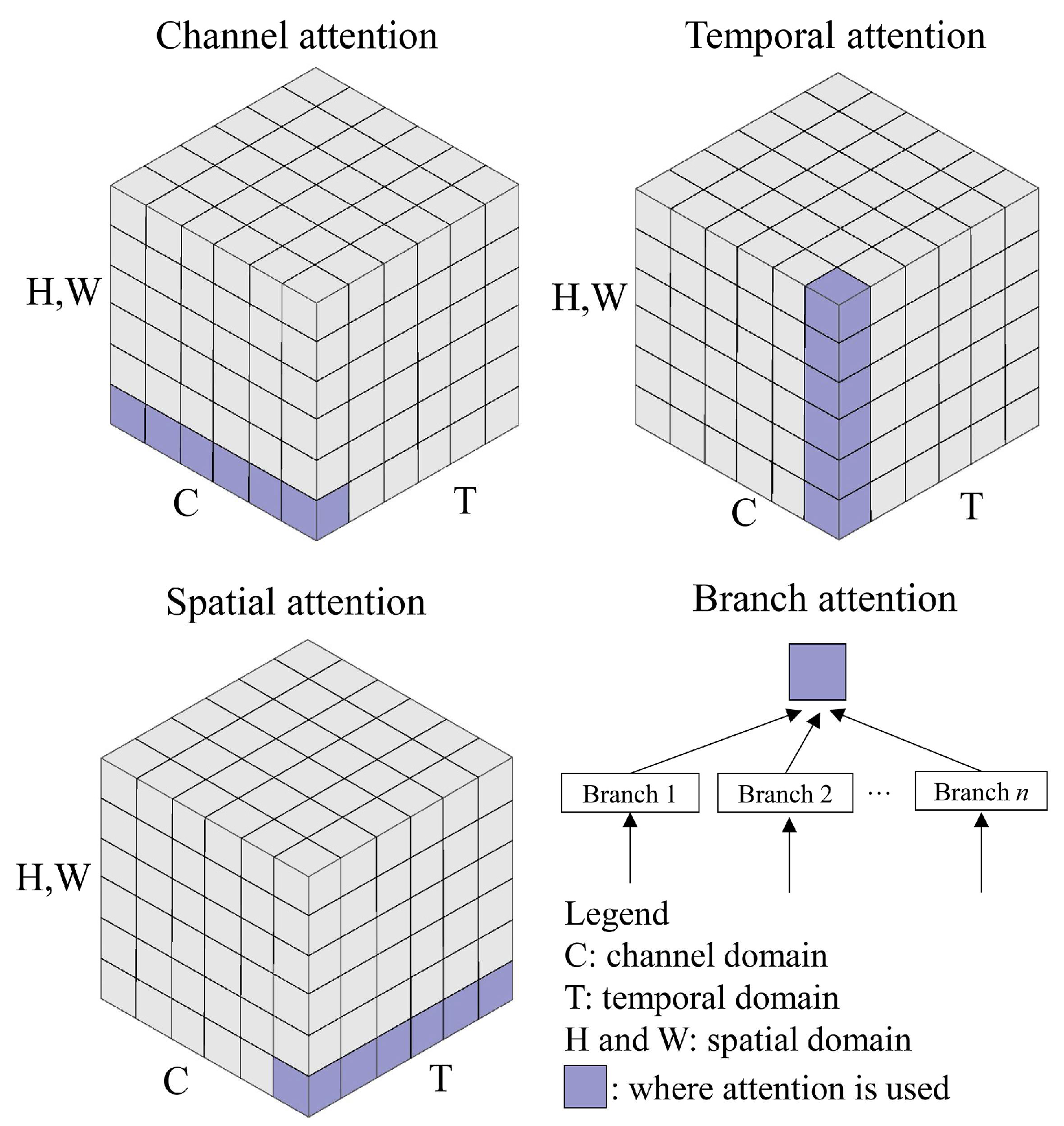
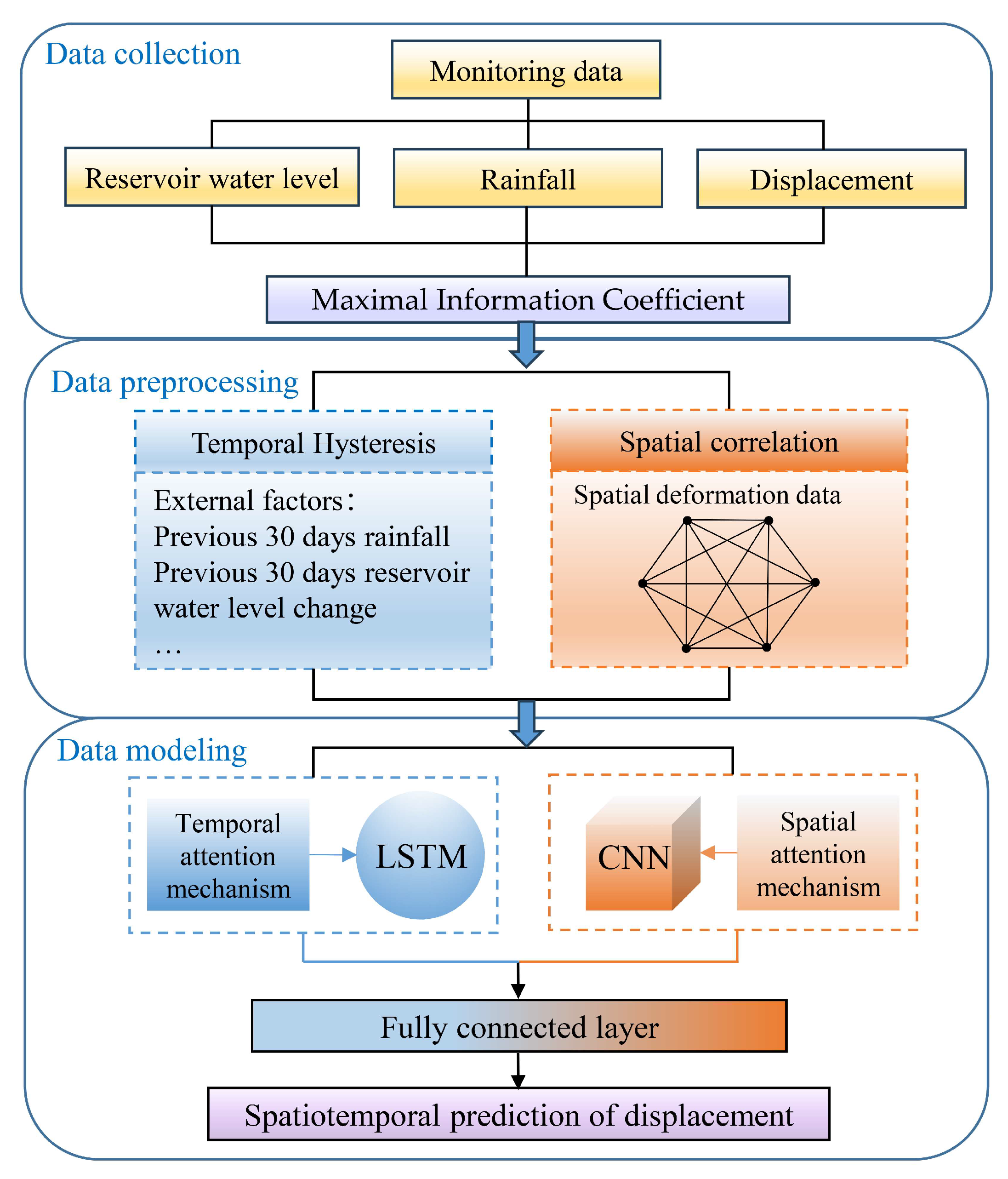
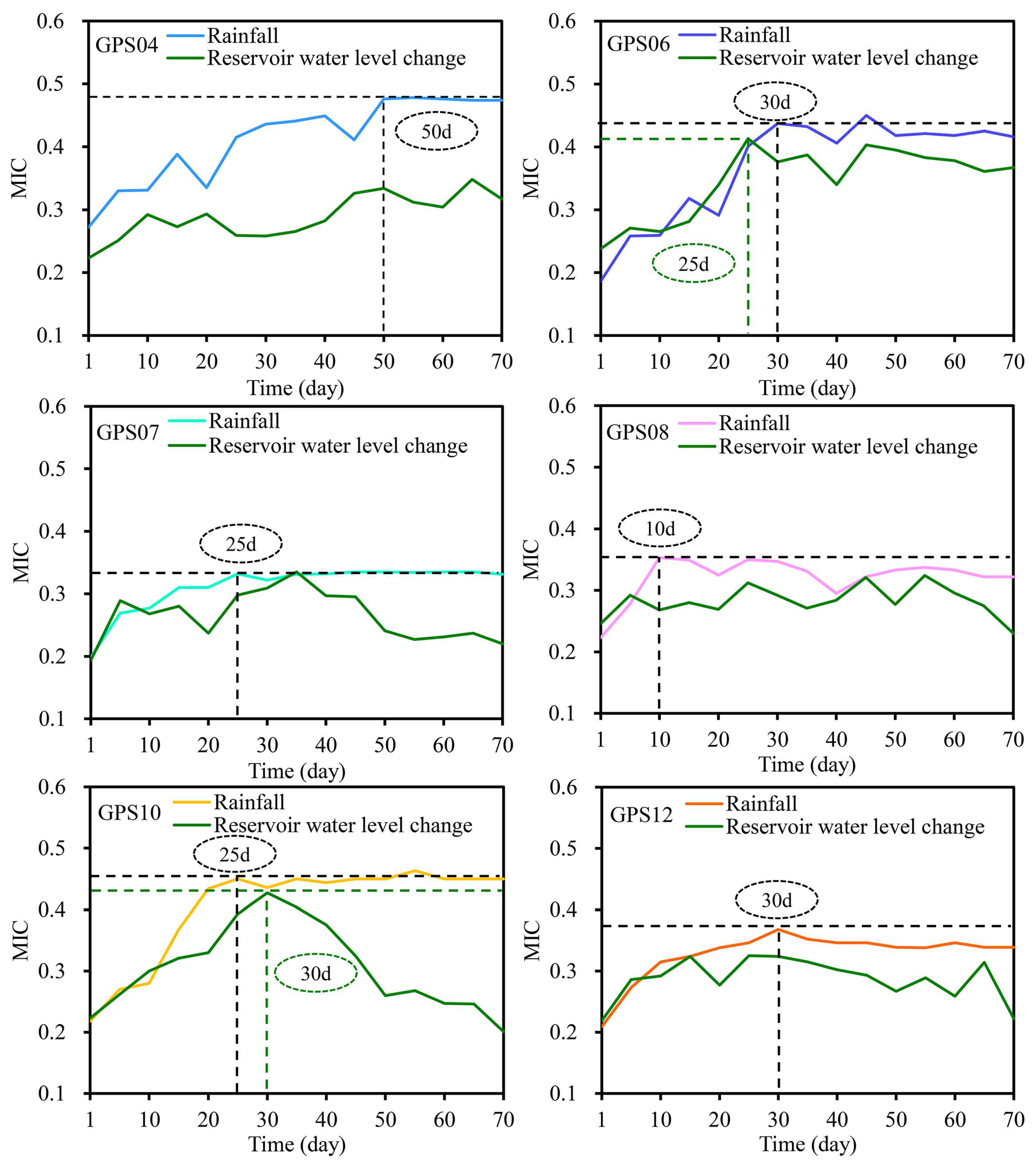
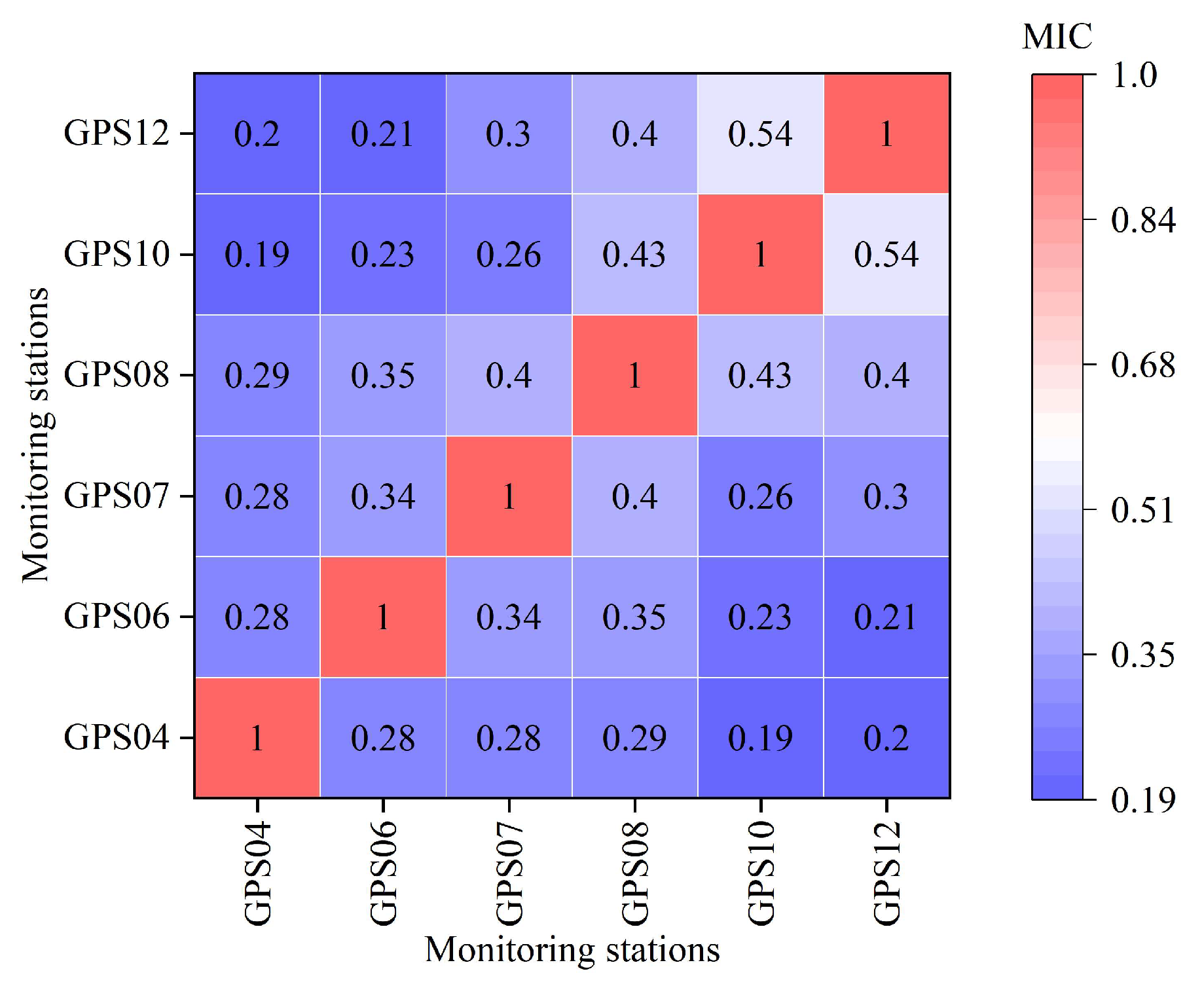
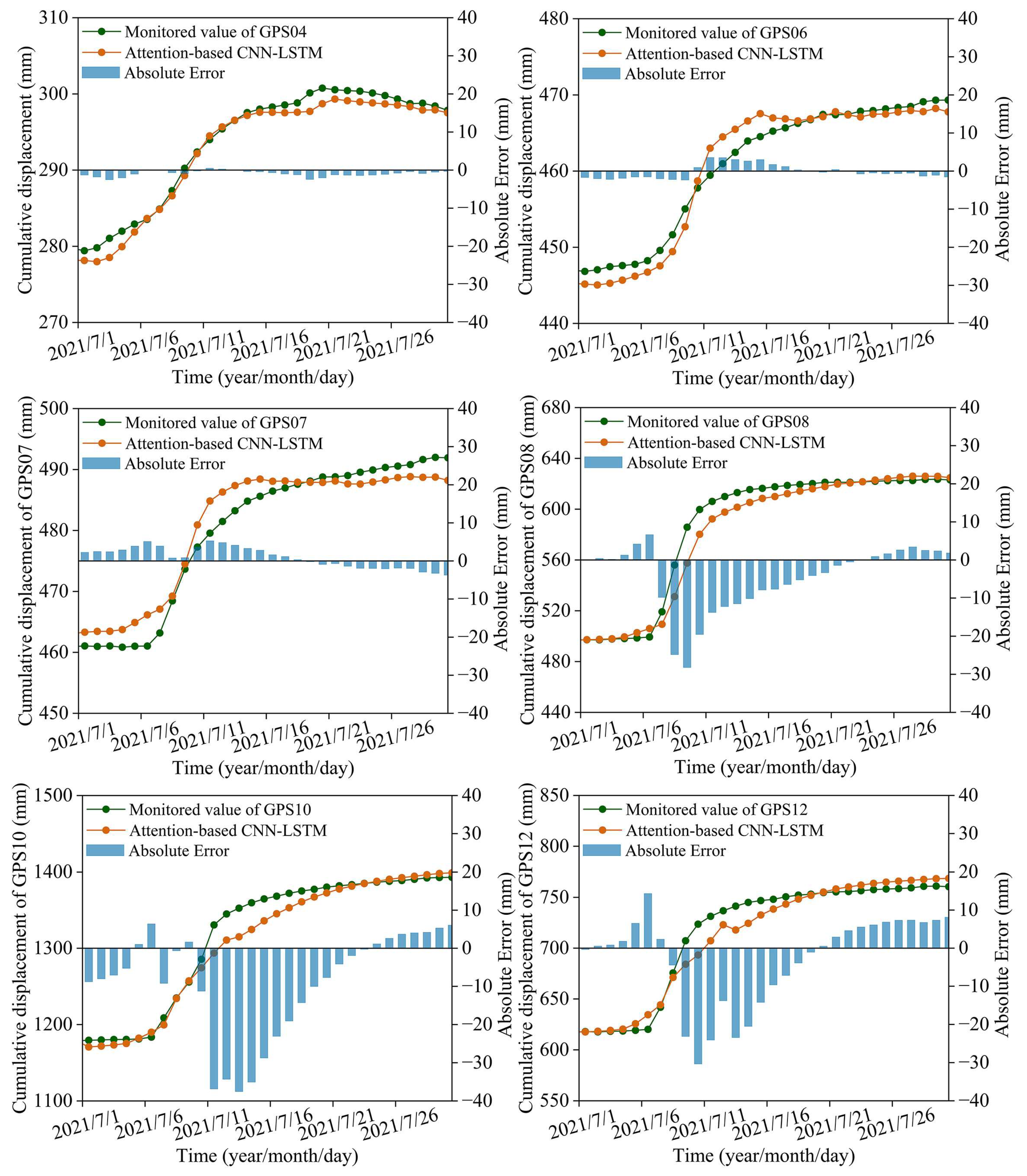


| Specifications | Details |
|---|---|
| CPU | Intel i7-1165G7 |
| Operating System | Windows10 |
| GPU Memory | 16 GB |
| GPU | MX350 |
| Development Language | Python 3.6 |
| Development Environment | Anaconda 3 |
| Machine Learning Framework | PyTorch 1.9.0 |
| Accuracy | GPS04 | GPS06 | GPS07 | GPS08 | GPS10 | GPS12 |
|---|---|---|---|---|---|---|
| RMSE (mm) | 1.18 | 1.80 | 2.84 | 9.64 | 16.21 | 11.91 |
| MAE (mm) | 0.99 | 1.51 | 2.47 | 6.29 | 10.95 | 8.58 |
| MAPE (%) | 0.34 | 0.33 | 0.52 | 1.07 | 0.82 | 1.18 |
| R2 | 0.9752 | 0.9555 | 0.9444 | 0.9989 | 0.9654 | 0.9580 |
Disclaimer/Publisher’s Note: The statements, opinions and data contained in all publications are solely those of the individual author(s) and contributor(s) and not of MDPI and/or the editor(s). MDPI and/or the editor(s) disclaim responsibility for any injury to people or property resulting from any ideas, methods, instructions or products referred to in the content. |
© 2023 by the authors. Licensee MDPI, Basel, Switzerland. This article is an open access article distributed under the terms and conditions of the Creative Commons Attribution (CC BY) license (https://creativecommons.org/licenses/by/4.0/).
Share and Cite
Yang, B.; Guo, Z.; Wang, L.; He, J.; Xia, B.; Vakily, S. Updated Global Navigation Satellite System Observations and Attention-Based Convolutional Neural Network–Long Short-Term Memory Network Deep Learning Algorithms to Predict Landslide Spatiotemporal Displacement. Remote Sens. 2023, 15, 4971. https://doi.org/10.3390/rs15204971
Yang B, Guo Z, Wang L, He J, Xia B, Vakily S. Updated Global Navigation Satellite System Observations and Attention-Based Convolutional Neural Network–Long Short-Term Memory Network Deep Learning Algorithms to Predict Landslide Spatiotemporal Displacement. Remote Sensing. 2023; 15(20):4971. https://doi.org/10.3390/rs15204971
Chicago/Turabian StyleYang, Beibei, Zizheng Guo, Luqi Wang, Jun He, Bingqi Xia, and Sayedehtahereh Vakily. 2023. "Updated Global Navigation Satellite System Observations and Attention-Based Convolutional Neural Network–Long Short-Term Memory Network Deep Learning Algorithms to Predict Landslide Spatiotemporal Displacement" Remote Sensing 15, no. 20: 4971. https://doi.org/10.3390/rs15204971
APA StyleYang, B., Guo, Z., Wang, L., He, J., Xia, B., & Vakily, S. (2023). Updated Global Navigation Satellite System Observations and Attention-Based Convolutional Neural Network–Long Short-Term Memory Network Deep Learning Algorithms to Predict Landslide Spatiotemporal Displacement. Remote Sensing, 15(20), 4971. https://doi.org/10.3390/rs15204971







